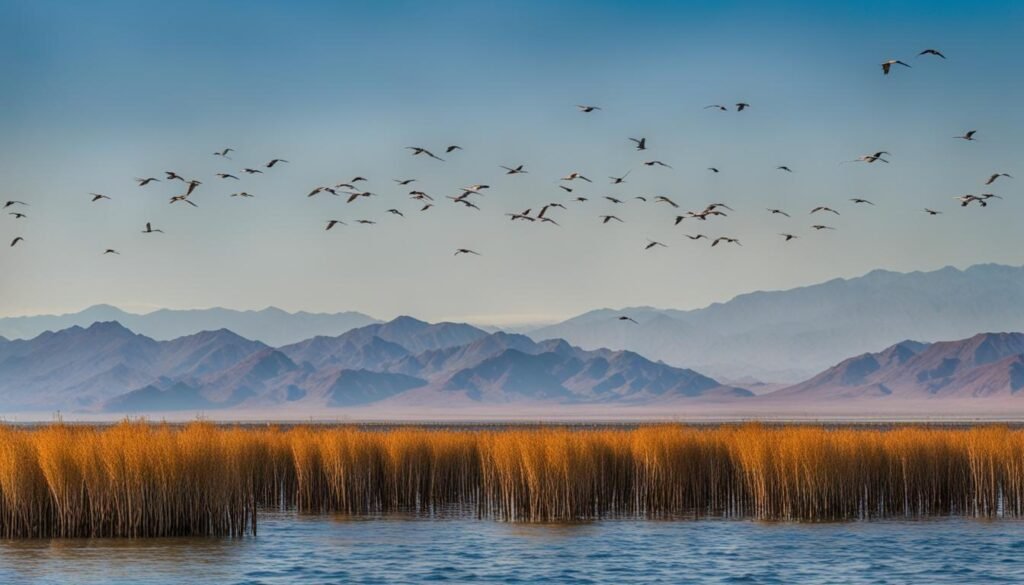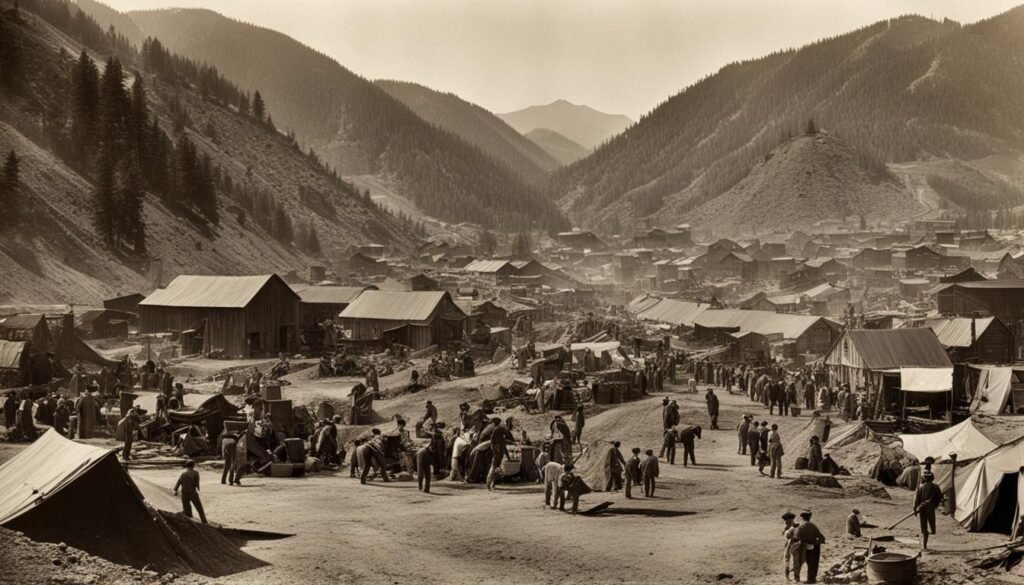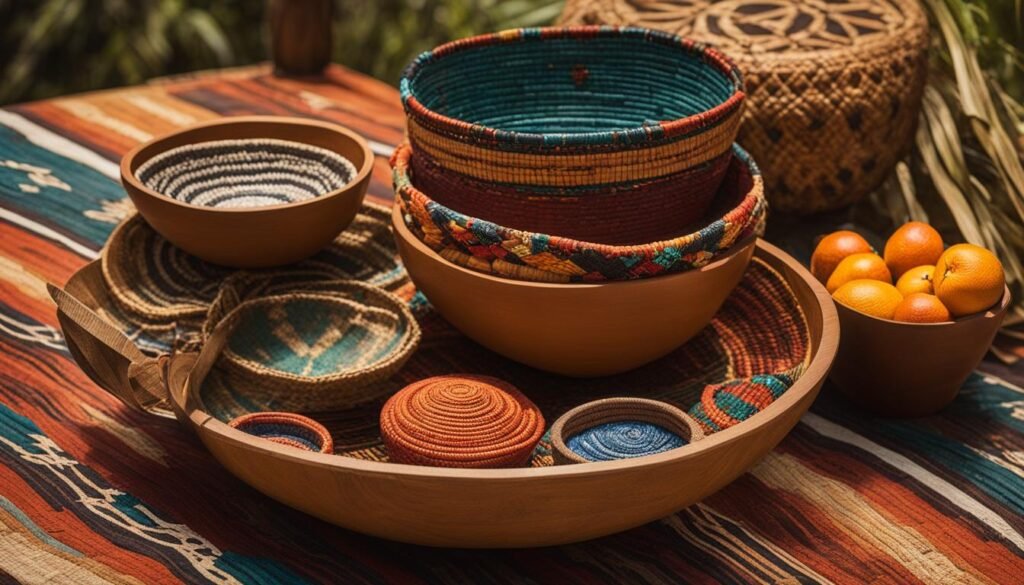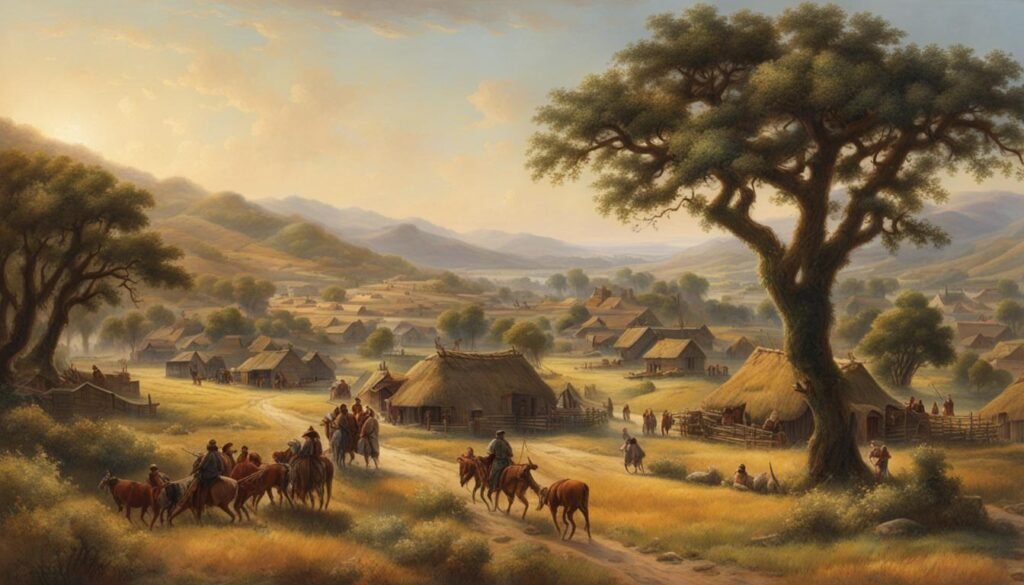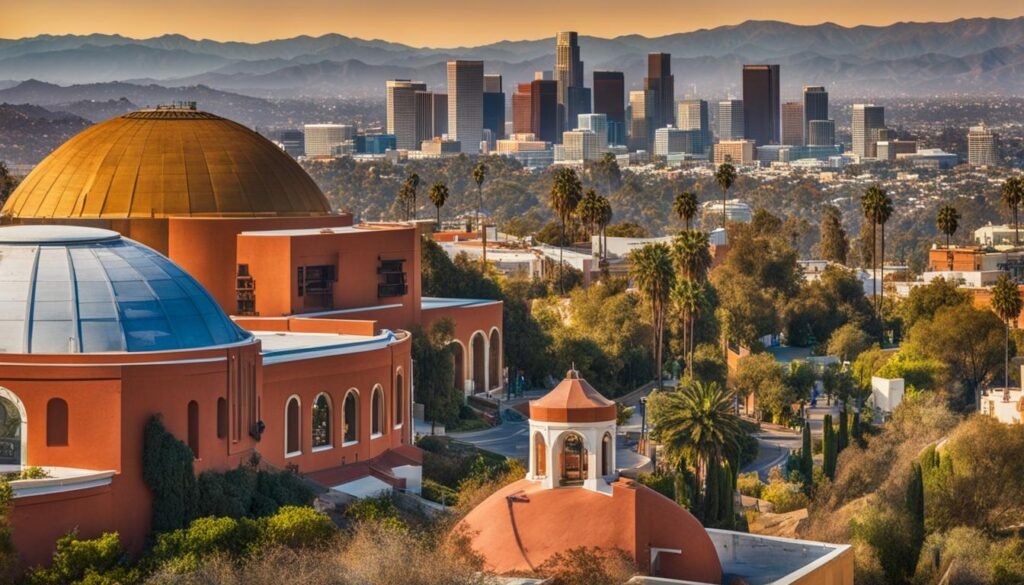Welcome to the Sonny Bono Salton Sea National Wildlife Refuge! As an avid nature lover, I am always excited to explore unique ecological havens like this one. Nestled in the Imperial Valley of California, the refuge offers a sanctuary for wildlife conservation amidst the picturesque landscape of the Salton Sea.
Spanning across diverse habitats, including marine, freshwater, wetland, and agricultural areas, the Sonny Bono Salton Sea National Wildlife Refuge is a paradise for bird species. With over 519 different wildlife species documented, including endangered and sensitive ones, this refuge is a birdwatcher’s delight.
One of the must-visit spots within the refuge is the Sonny Bono Salton Sea National Wildlife Refuge Visitor Center. Here, you can dive deeper into the ecological importance of the refuge, learn about the varied species that call it home, and understand the critical conservation efforts undertaken by the U.S. Fish and Wildlife Service.
Key Takeaways:
- The Sonny Bono Salton Sea National Wildlife Refuge is an ecological haven situated in the Imperial Valley of California.
- It offers diverse habitats, including marine, freshwater, wetland, and agricultural areas.
- The refuge is a popular destination for birdwatchers, with over 519 wildlife species documented, including endangered ones.
- Don’t miss the opportunity to visit the Sonny Bono Salton Sea National Wildlife Refuge Visitor Center to learn more about its ecological significance.
- The refuge is a testament to the importance of wildlife conservation and protecting our natural heritage for future generations.
Wildlife Diversity at the Refuge
The Sonny Bono Salton Sea National Wildlife Refuge is home to a remarkable array of wildlife, showcasing the richness and diversity of the Salton Sea ecosystem. Established in 1930, this refuge has served as a vital sanctuary for various species, adapting to the changing salinity and water levels of the area.
With over 519 documented species, the refuge is a haven for wildlife enthusiasts and birdwatchers alike. Among these species, there are 433 bird species, including pelicans, sandpipers, grebes, ducks, and geese, making it a paradise for salton sea birdwatching and birding salton sea.
Not limited to birds, the refuge also supports an impressive variety of mammals, reptiles, and amphibians. In total, there are 41 mammal species, 22 reptile and amphibian species, and 15 fish species that call the refuge their home.
One of the most remarkable sights at the Salton Sea is the abundance of migratory birds. Over 124,000 shorebirds, representing at least 25 different species, make use of the Salton Sea as a crucial staging area along the Pacific Flyway. Witnessing the spectacle of these birds in flight is a sight to behold, and salton sea bird watching provides an exceptional opportunity for nature lovers to immerse themselves in the wonders of avian life.
- The Sonny Bono Salton Sea National Wildlife Refuge is home to over 519 documented wildlife species, including 433 bird species, 41 mammals, 22 reptiles and amphibians, and 15 fish species.
- Migratory birds, such as pelicans, sandpipers, grebes, ducks, and geese, are abundant at the refuge.
- The refuge also hosts a diverse range of mammals, reptiles, and amphibians, contributing to the overall biodiversity of the area.
- Birdwatchers and wildlife enthusiasts can immerse themselves in the beauty of nature and enjoy the prime location for salton sea birdwatching and birding salton sea.
Refuge Habitats
The Sonny Bono Salton Sea National Wildlife Refuge is home to a diverse wildlife population, thanks to its various habitats. The refuge encompasses croplands, native desert upland habitat, and wetlands, providing a haven for a wide range of species.
- The croplands cover approximately 869 acres and serve as a valuable food source for tens of thousands of wintering geese and other migratory birds and wildlife.
- The native desert upland habitat, consisting of tree rows planted by refuge staff, recreates the Sonoran desert environment and offers food and shelter to native wildlife species.
- The wetlands, covering 826 acres, are crucial for resident and migratory bird species. Some of the wetland units are kept permanently watered, providing nesting habitat for the endangered Yuma Ridgeway’s rail. Others mimic naturally ephemeral wetlands and serve as important food sources and cover for ducks, shorebirds, and wading birds.
The diverse habitats found within the refuge contribute to its status as a California bird sanctuary, attracting a wide range of bird species. The Sonny Bono Salton Sea National Wildlife Refuge is a true haven for wildlife, providing essential resources and creating a thriving ecosystem.

The Salton Sea’s Environmental Challenges
The Salton Sea, once a thriving tourist attraction and popular fishing destination, has faced numerous environmental challenges. Due to evaporation, reduced water inflows, and high levels of salinity, the sea’s ecosystem has been significantly impacted. Disease outbreaks have affected birds and fish populations, causing declines in their numbers. The increasing salinity and decreasing water levels have led to changes in the types of species that can thrive in the sea.
The Corvina, a gamefish species, and other freshwater fish populations have declined, while saltwater species like tilapia have become more prevalent. These changes have had a cascading effect on the food web, altering the dynamics of the entire ecosystem. The delicate balance that once existed in the Salton Sea has been disrupted, resulting in the loss of biodiversity and the degradation of habitats.
Recognizing the environmental impact of these challenges, conservation efforts have been initiated to preserve and restore the Salton Sea’s ecosystem. Projects aimed at reducing salinity, restoring water inflows, and establishing control measures for disease outbreaks are in progress. These initiatives are crucial in mitigating the effects of the environmental challenges and ensuring the long-term sustainability of the sea and its surrounding habitats.
Amidst these efforts, the Sonny Bono Salton Sea National Wildlife Refuge plays a vital role in conserving and protecting the affected species. The refuge provides sanctuary for wildlife affected by the sea’s environmental challenges, ensuring their survival and providing them with a safe haven. It serves as a crucial stepping stone for the migration of birds and supports a diverse array of species, contributing to the overall biodiversity of the region.

Importance for Bird Migration
The Salton Sea and the Sonny Bono Salton Sea National Wildlife Refuge play a vital role in the migration of birds. As an internationally recognized staging area, the Salton Sea attracts over 124,000 shorebirds of at least 25 different species during their journey along the Pacific Flyway. Many bird species depend on the Salton Sea as a critical stopover and feeding ground.
Birdwatchers can witness the incredible diversity of avian life at the Salton Sea and its surrounding refuge. Among the shorebirds that rely on the sea’s habitats, you may spot Western sandpipers, willets, least sandpipers, American avocets, red-necked phalaropes, and black-necked stilts. However, the area is not limited to shorebirds alone; you’ll find a plethora of other bird species as well.
Birdwatching at the Salton Sea
If you’re an avid birdwatcher, the Salton Sea and its refuge offer an exceptional opportunity to observe migratory species and enjoy the spectacle of thousands of birds in flight. You can explore various habitats that attract a wide range of bird species, from wetlands to croplands and native desert upland areas.
To enhance your birdwatching experience, be sure to visit birding hotspots within the refuge, such as the Sonny Bono Salton Sea National Wildlife Refuge Visitor Center. This center provides valuable resources and information about the birds and their habitats. With your binoculars and camera in hand, you’ll be able to capture stunning images of the abundant avian life that calls the Salton Sea home.
Whether you’re a seasoned birder or a novice enthusiast, exploring the Salton Sea and its refuge will leave you in awe of the remarkable bird migration phenomenon and the rich biodiversity it supports.
- Witness the incredible diversity of avian life during bird migration.
- Observe a wide range of bird species, including shorebirds like Western sandpipers, willets, and black-necked stilts.
- Explore different habitats at the refuge, including wetlands, croplands, and native desert upland areas.
- Enhance your birdwatching experience by visiting birding hotspots and the Sonny Bono Salton Sea National Wildlife Refuge Visitor Center.
Conclusion
The Sonny Bono Salton Sea National Wildlife Refuge is a testament to the resilience of nature and the significance of wildlife conservation. Despite the environmental challenges faced by the Salton Sea, the refuge has provided a safe haven for a diverse array of wildlife species. From critical stopover and nesting sites for migratory birds to rich habitats for mammals, reptiles, and amphibians, the refuge plays a vital role in preserving the region’s biodiversity.
With its wetlands, croplands, and native desert upland habitat, the refuge offers essential food and shelter for the wildlife that calls the Salton Sea home. Visitors who explore the refuge and engage in birdwatching activities will experience the magnificence and complexities of nature firsthand. It is a chance to witness the beauty of the Salton Sea’s ecosystem and gain a deeper appreciation for the importance of wildlife conservation.
The Sonny Bono Salton Sea National Wildlife Refuge stands as a shining example of the dedication to preserving our natural heritage. Through ongoing conservation efforts, the tragic environmental challenges faced by the Salton Sea can be addressed, and the refuge can continue to thrive. As we strive for renewable energy solutions and promote sustainable practices, we can ensure the long-term well-being of the Salton Sea and its unique wildlife. Together, we can safeguard this ecological haven for future generations to enjoy and cherish.
FAQ
Is the Sonny Bono Salton Sea National Wildlife Refuge open to the public?
Yes, the Sonny Bono Salton Sea National Wildlife Refuge is open to the public. Visitors can explore the refuge and learn more about its ecological importance at the Sonny Bono Salton Sea National Wildlife Refuge Visitor Center.
What kind of wildlife can be found at the refuge?
The Sonny Bono Salton Sea National Wildlife Refuge is home to a diverse array of wildlife species, including over 433 bird species, 41 mammals, 22 reptiles and amphibians, and 15 fish species.
Why is the Salton Sea important for birdwatching?
The Salton Sea is a popular destination for birdwatchers due to its status as an internationally important staging area for shorebirds along the Pacific Flyway. Over 124,000 shorebirds of at least 25 species migrate through the area, attracting birdwatching enthusiasts from around the world.
How does the refuge support wildlife conservation?
The Sonny Bono Salton Sea National Wildlife Refuge provides habitat for a wide range of wildlife species, including several that have been listed as endangered or sensitive by the U.S. Fish and Wildlife Service. It plays a crucial role in preserving and protecting the ecosystem of the Salton Sea.
What are the environmental challenges facing the Salton Sea?
The Salton Sea has faced issues such as reduced water inflows, high levels of salinity, and disease outbreaks that have significantly impacted its ecosystem. These challenges have led to changes in species composition and declines in bird and fish populations.
Why is the Salton Sea important for bird migration?
The Salton Sea serves as a critical stopover and feeding ground for migratory birds along the Pacific Flyway. It provides essential habitat and resources that support the long journeys of many bird species, making it a crucial site for bird migration.

